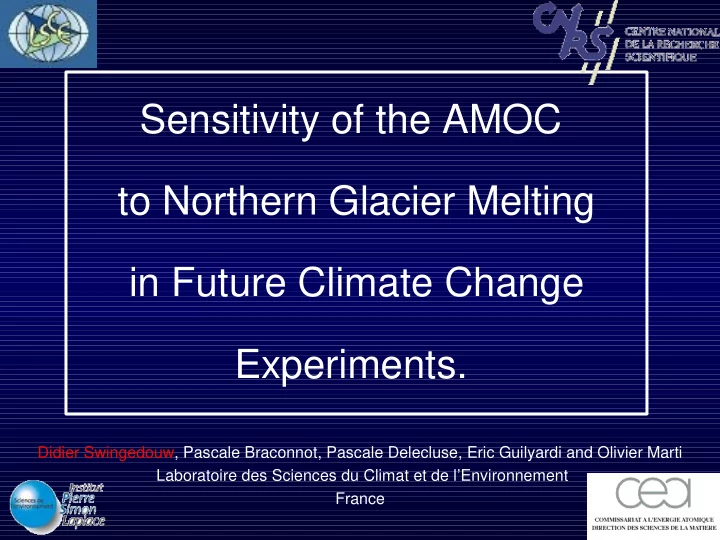

Sensitivity of the AMOC to Northern Glacier Melting in Future Climate Change Experiments. Didier Swingedouw, Pascale Braconnot, Pascale Delecluse, Eric Guilyardi and Olivier Marti Laboratoire des Sciences du Climat et de l’Environnement France
Background IPCC 2001 : None of the GCM model includes melting of land-ice (Greenland, Antarctic and mountain glaciers) EMICs: collapse of AMOC for a freshwater input of 0.2 Sv (Rahmstorf, 1995) Fichefet et al. (2003) : using Greenland Ice-sheet model coupled to a GCM melting of Greenland could be an important term for the AMOC response to global warming
Aim of this work Estimate simply land ice and snow melting and freshwater return to the ocean, in order to consider the climatic impact of land-ice (glacier) melting in scenario simulation Analyze the climatic feedbacks triggered by a weakening of the AMOC due to the additional freshwater input by land-ice melting on a 100 years time-scale
Tool: IPSL-CM4 coupled GCM Paris, France IPSL-CM4: - Ocean ORCA2: 2°*(0.5-2°) resolution - Sea-ice LIM: dynamic-thermodynamic - Atmophere LMDz: 3.75° resolution - Land model ORCHIDEE with a correct river routing scheme Closure of the water budget • The land-snow melted can go back to the ocean through runoff • A crude parametrization of iceberg dynamics is implemented • The land-ice could also melt in order to simulate glacier melting. Different regions for the calving
Experimental design (1/2) Two versions of Ta the IPSL-CM4 model: 2) With Glacier Snow melting Ice Sheet Ocean Land
Experimental design (1/2) Two versions of Ta the IPSL-CM4 model: 2) With Glacier Snow melting 2) Without Glacier Ice Sheet melting Ocean Land
Experimental design (2/2) CMIP2 like scenario: The atmospheric CO2 CO2 concentration concentration is increased by 1%/yr, which is an Transient Without idealized scenario Transient With CTL We focus on the 2*CO2 4*CO2 transient period of 140 years, up to 4*CO2 CTL : « Control » pre-industrial simulation 0
AMOC response AMOC index AMOC index CTL CTL Without Glacier melting With Glacier melting 2*CO2 4*CO2 2*CO2 4*CO2
Without-With: Freshwater input by glacier melting AMOC response and Additional Freshwater input 2*CO2 4*CO2 AMOC index CTL • About 0.1Sv at 2*CO2 and 0.2Sv at 4*CO2 • 20% of Greenland Without Glacier melting melted in the 140 years of experiments With Glacier melting 2*CO2 4*CO2 • « Worst case » melting scenario (Gregory , 2004)
Difference in Surface temperature between scenarios at 4*CO2: Effect of less AMOC weakening Without - WithfoMelting • Global difference of 0.44 K
Difference in Surface temperature between scenarios at 4*CO2: Effect of less AMOC weakening Without - WithfoMelting • Global difference of 0.44 K • Difference of 0.85 K in the North Hemisphere, 0.07 K in the South
Difference in Surface temperature between scenarios at 4*CO2: Effect of less AMOC weakening Without - WithfoMelting + 8 K • Global difference of 0.44 K • Difference of 0.85 K in the North Hemisphere, -0.07 K in the South • Most of the warming happens where sea-ice cover disapears (Barents Sea)
Additional warming: Two possible ocean processes 1. Local freshening of the Arctic => local sea-ice interaction 2. Difference in AMOC => Less northward heat transport
Average on the Arctic of: CTL Additional warming: Two possible ocean Without processes Freshwater Forcing With 1. Local freshening of the Arctic Mixed Layer Depth => local sea-ice interaction SST 2. Difference in AMOC => Less northward heat transport Sea-Ice Cover
Average on the Arctic of: CTL Additional warming: Two possible ocean Without processes Freshwater Forcing With 1. Local freshening of the Arctic Mixed Layer Depth => local sea-ice interaction SST 2. Difference in AMOC => Less northward heat transport Sea-Ice Cover
Average on the Arctic of: CTL Additional warming: Two possible ocean Without processes Freshwater Forcing With 1. Local freshening of the Arctic Mixed Layer Depth => local sea-ice interaction SST 2. Difference in AMOC => More northward heat transport Timing pleads for this process As difference in heat transport: +0.17 PW at 20°N +0.05 PW at 50°N Sea-Ice Cover
Conclusions Land-ice melting leads to important AMOC weakening in the IPSL-CM4, and thus needs to be taken into account in coupled model AMOC changes appear after 60 years of glaciers melting integration, and then trigger a fast positive climate feedback trough sea-ice cover Coupling with a full ice sheet model to validate our land-ice parameterization (in progress)
Thank you mailto: didier.swingedouw@cea.fr
Recommend
More recommend